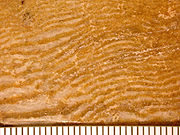
Eozoon
Encyclopedia

Pseudofossil
Pseudofossils are inorganic objects, markings, or impressions that might be mistaken for fossils. Pseudofossils may be misleading, as some types of mineral deposits can mimic lifeforms by forming what appear to be highly detailed or organized structures. One common example is when manganese oxides...
.
John William Dawson
John William Dawson
Sir John William Dawson, CMG, FRS, FRSC , was a Canadian geologist and university administrator.- Life and work :...
(1865) described the banded structures of coarsely crystalline calcite
Calcite
Calcite is a carbonate mineral and the most stable polymorph of calcium carbonate . The other polymorphs are the minerals aragonite and vaterite. Aragonite will change to calcite at 380-470°C, and vaterite is even less stable.-Properties:...
and serpentine as a gigantic Foraminifera
Foraminifera
The Foraminifera , or forams for short, are a large group of amoeboid protists which are among the commonest plankton species. They have reticulating pseudopods, fine strands of cytoplasm that branch and merge to form a dynamic net...
, making it the oldest known fossil. It was found in Precambrian
Precambrian
The Precambrian is the name which describes the large span of time in Earth's history before the current Phanerozoic Eon, and is a Supereon divided into several eons of the geologic time scale...
metamorphosed limestone
Limestone
Limestone is a sedimentary rock composed largely of the minerals calcite and aragonite, which are different crystal forms of calcium carbonate . Many limestones are composed from skeletal fragments of marine organisms such as coral or foraminifera....
of Canada
Canada
Canada is a North American country consisting of ten provinces and three territories. Located in the northern part of the continent, it extends from the Atlantic Ocean in the east to the Pacific Ocean in the west, and northward into the Arctic Ocean...
, at Côte St. Pierre near Grenville
Grenville-sur-la-Rouge, Quebec
Grenville-sur-la-Rouge is a municipality in the Argenteuil Regional County Municipality, Quebec, Canada. It is a predominantly Francophone municipality situated along the southern border of Quebec between Montreal and Ottawa...
(Quebec
Quebec
Quebec or is a province in east-central Canada. It is the only Canadian province with a predominantly French-speaking population and the only one whose sole official language is French at the provincial level....
) in 1863. It was later found in several other localities. Dawson called it "one of the brightest gems in the scientific crown of the Geological Survey of Canada". In 1894, it was shown that the place where it was found was associated with metamorphism (O'Brien, 1970; Adelman, 2007).
Similar Eozoön structures were subsequently found in metamorphosed limestone blocks erupted from Mt. Vesuvius, where high-temperature physical and chemical processes were responsible for their formation (O'Brien, 1970).

